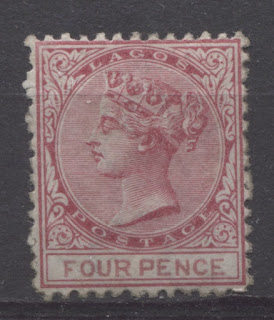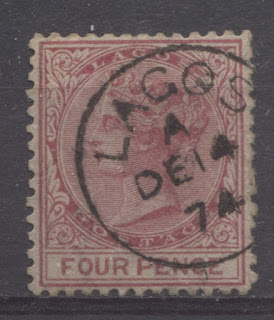Distinguishing the Seven Printings of the 4d Carmine Surface Printed Lagos Stamp Watermarked Crown CC and Perforated 12.5
Today's post will deal with the fourth, and one of the most complicated denominations of this first issue of Lagos, the 4d carmine. Seven printings were made of this stamp between May 12, 1874 and May 13, 1875.
This post will attempt to explain how to distinguish the seven printings of these stamps using the following characteristics:
1. Cancellations.
2. Colour shades.
3. Paper differences.
The discussion in my first post about the 1d, where I talk about the significance of the various cancellations used on this issue applies equally to this value as well. I am not going to repeat the details of that discussion here, but will instead provide a link to that discussion:
http://naijastamps.blogspot.ca/2016/10/distinguishing-six-printings-of-1d.html
However, the dates found on the Lagos CDS cancellations can be utilized to distinguish the various printings as follows:
First Printing - Dispatched May 12, 1874
Fourth Printing - Dispatched November 18, 1874
The last printing is by far the most common, but perhaps not in used condition, judging from the fact that of all my used examples of this stamp, only 2 come from this printing. This printing consisted of 105 sheets, being 6,300 stamps - close to 1/3rd of the total issue. This printing appears to have been printed in carmine - both for the head plate and duty plate. This example shows a nice, clear example of the Lagos diamond barred grid cancellation.
Rose-carmine & brown-carmine. Bright crimson & brown-carmine.
Carmine & brown-lake. Carmine-lake.
Carmine.
This post will attempt to explain how to distinguish the seven printings of these stamps using the following characteristics:
1. Cancellations.
2. Colour shades.
3. Paper differences.
The discussion in my first post about the 1d, where I talk about the significance of the various cancellations used on this issue applies equally to this value as well. I am not going to repeat the details of that discussion here, but will instead provide a link to that discussion:
http://naijastamps.blogspot.ca/2016/10/distinguishing-six-printings-of-1d.html
However, the dates found on the Lagos CDS cancellations can be utilized to distinguish the various printings as follows:
- First printings should be cancelled between late July 1874 and September 1875, though some may be cancelled as late as January 1875.
- Second printings should be cancelled between September 1874 and December 1874.
- Third printings will be cancelled between early October 1874 and January 1875, with a few being cancelled with the Lagos diamond barred grid.
- Fourth printings will be cancelled between December 1874 and September 1875.
- Fifth printings will be cancelled between February 1875 and October 1875, with a few being cancelled with the Lagos diamond grid cancel that was introduced in February 1876.
- Sixth printings will be cancelled between April 1875 and August 1875, with the later 1876 Lagos diamond grid cancel being common.
- Seventh printings will be cancelled after July 1875 to early 1876. All the used examples I have seen are cancelled with the Lagos diamond grid cancel.
There appears to be quite a bit of overlap in the usage dates, which suggests quite strongly that the subsequent printings were ordered, and received well before the earlier supplies had been fully exhausted. Indeed, my classification of the printings is my best guess, based on the relative number of different dates in each group. Thus each printing may have stamps dated in July 1875 for example, but if most of the dates in one group are later than most of the dates in another, then it is reasonable to conclude that the stamps of the first group are from a later printing than the group with the mostly earlier dates. One thing that makes this value more difficult to sort is that the number of shades on this stamp is greater than the number of printings. However, many can be grouped in such a way that the number of groups corresponds to the seven printings.
The first printing is the scarcest of the seven, consisting of a mere 32 sheets of 60, or 1,920 stamps. It is identifiable by the shade, which is rose-carmine. Both the head plate and the duty plate (words of value) are the same shade, which suggests that they were printed in one operation. I identified this as the first printing on the basis of the fact that it has the earliest cancellation I have seen - June 18, 1874, which pre-dates the dispatch of the second printing.
Here is the back of that stamp. The gum is smooth, thin and colourless, as is the case with gum during the crown-CC period. This paper is smooth, with no distinct mesh.
Here is the earliest dated used example I have seen, cancelled June 18, 1874.
And the back. Once again, the paper is smooth, with no distinct mesh.
Second Printing - Dispatched August 13, 1874
This printing is the second rarest, with only 36 sheets of 60 being printed, or 2,160 stamps. On this printing, there is a marked difference between the colour of the head plate, and the colour of the duty plate, with the head plate being printed in carmine, and the duty plate being printed in brown-rose. These colours are different enough that we can conclude they came from separate batches of ink, which means that this printing was done in two operations.
Here is the back of this stamp. The gum has been somewhat disturbed, but is clear and smooth, as with the first printing. The paper again is smooth, with no distinct mesh.
Here is a used example, dated October 12, 1874. This example also shows a small manuscript "c", which is thought to be an ownership mark that was applied at the post office, where the stamp was applied. Some customers who lived far from the post office, would purchase stamps on account to be held at the post office and used by the postal clerk as needed when outgoing mail was received by the post office. The ownership marks were applied so that the clerk could distinguish whose stamps were whose.
The back of this stamp also does not show any distinct mesh.
Third Printing - Dispatched September 14, 1874
The third printing consisted of 42 sheets of 60 stamps, or 2,520 stamps. The duty plate colour remained brown-rose, but the head plate is much paler, being a pale rose-carmine.
This example is unused, so I cannot comment on the gum. However, the paper on this printing appears to include both paper showing no mesh, and paper showing feint vertical mesh.
This used example is dated only 1 day before the example above for the second printing. So, it is possible that this printing really is a sub-variety of the second printing, rather than the third printing. However, there was barely a month between the dispatches of the second and third printings. That lends some support to the idea that this really is a separate printing.
This example is printed on paper that shows no distinct mesh, similar to the first two printings.
This example is cancelled with the Lagos diamond barred grid, which was introduced in February 1876. This is very late, and must have come from a few stamps left at the bottom of the stock of one of the more remote post offices. This stamp would have sat at the bottom of the "pile", not being used until 1876, when the last of the stamps on hand were being used.
This example is on paper showing feint vertical mesh.
The fourth printing is the third most common, with 53 sheets being printed, or 3,180 stamps. Unfortunately, I do not have any mint examples of this printing to show here. Like the other printings, the duty plate and head plates were printed in completely different colours. The head plate was printed in carmine, and the duty plate was printed in brown-lake. This example is cancelled December 14, 1874, which is very early for a stamp that was dispatched almost a month earlier. However, the other two examples I have seen are dated September 24, 1875 and March 26, 1875.
This example, once again, has the smooth paper, that shows no distinct mesh.
Fifth Printing - Dispatched December 14, 1874
The fifth printing consisted of 51 sheets, or 3,030 stamps. This appears to be the first printing in which we see some variation in shade. I have three examples to show here, each of which is printed in a slightly different combination of head plate and duty plate shades. This example, dated May 20, 1875 has the head plate printed in rose carmine, and the duty plate printed in brown carmine.
The paper once again shows no distinct mesh, appearing very similar to all the earlier printings.
This second example, dated October 27, 1875 has the head plate printed in bright crimson, and the duty plate printed in the same brown carmine as the previous stamp.
And the same, smooth wove paper as the other stamp as well. This one is from the edge of the sheet, as it shows the vertical border that formed part of the watermark at the outer perimeter of the sheets.
This example has the head plate being printed in carmine, but the duty plate is printed in brown-lake.
Once again, the paper is smooth and shows no distinct mesh.
Sixth Printing - Dispatched February 3, 1875
This second last printing, like the fourth printing consisted of 53 sheets, or 3,180 stamps. Like the first printing, it seems to have been printed in one operation, as the head plate and the duty plate are both printed in carmine-lake, and the words of value are generally very well centered within the value tablets, which suggests that they were laid out prior to printing. This example, dated August 21, 1875 is within two months of the other two dated examples that I have seen, which are June 8, 1875, and August 20, 1875.
The back of this stamp is also on the smooth wove paper, that shows no distinct mesh.
Seventh Printing - Dispatched May 13, 1875
The last printing is by far the most common, but perhaps not in used condition, judging from the fact that of all my used examples of this stamp, only 2 come from this printing. This printing consisted of 105 sheets, being 6,300 stamps - close to 1/3rd of the total issue. This printing appears to have been printed in carmine - both for the head plate and duty plate. This example shows a nice, clear example of the Lagos diamond barred grid cancellation.
This example is clearly printed on paper that shows clear vertical mesh, in common with the last printings of the other denominations.
Here is another example, printed in a slightly paler shade of carmine. Again, both the head plate and duty plate are printed in the same colour.
This example is on the same type of paper showing distinct vertical mesh.
This concludes my discussion of this value. I most likely will update it, and may change the designation of certain printings as I examine more examples and more information comes to light. I would greatly appreciate any information you may have, or scans that would help provide further evidence in regard to the correct classification of the various printings of these stamps.
This is my last post until the second week of December 2016. I am moving to New Brunswick next week, so will not have time to complete a post next week. I should be settled in by the following week, and will resume my series of posts that week with a post detailing the seven printings of the 6d green.
To recap, I show the various printings and shades side by side:
Rose-carmine. Carmine & brown-rose.
Pale rose-carmine & brown-rose. Carmine & brown-lake.
Rose-carmine & brown-carmine. Bright crimson & brown-carmine.
Carmine & brown-lake. Carmine-lake.
Carmine.







































Comments
Post a Comment